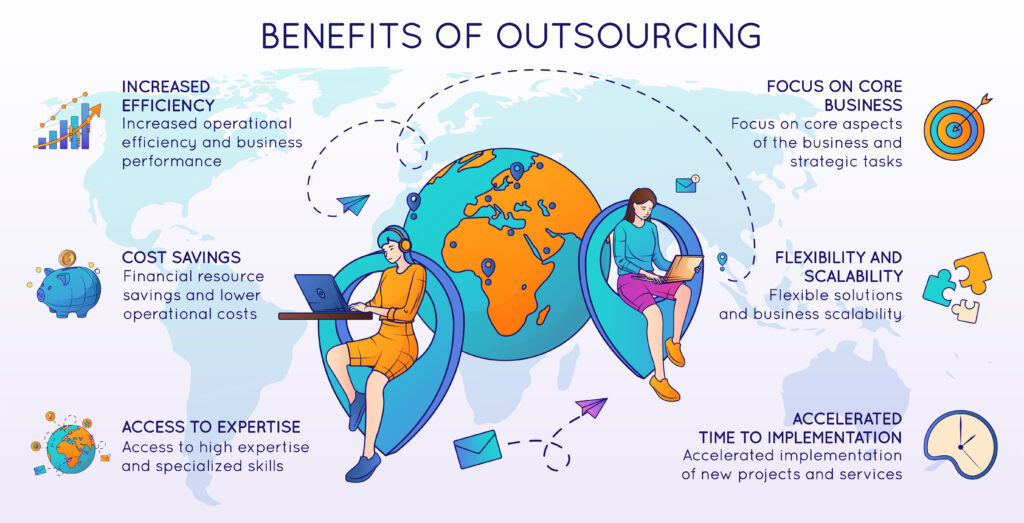In today’s digital age, businesses of all sizes are increasingly turning to IT outsourcing services to optimize their operations and gain a competitive edge. But what exactly is IT outsourcing, and how can it benefit your company? Let’s find out with Levinci in this article!
IT outsourcing services definition
In simpler terms, IT outsourcing is like hiring an outside company to handle some of your tech tasks. Instead of having your own IT staff for everything, you can outsource specific jobs to specialists.

IT outsourcing services will handle functions such as software development, infrastructure management, technical support, network administration and network security. By cooperating with IT outsourcing services, businesses can focus internal resources on their core business activities, save costs, and access today’s most advanced technology.
3 main types of IT outsourcing services
Onshore outsourcing
Onshore outsourcing involves contracting an IT service provider located in the same country as your business. It means hiring an external company within your borders to handle some of your IT tasks. Here are the key advantages of onshore outsourcing:
- Smoother communication and collaboration: Because onshore outsourcing operates in the same territory and country as your business, sharing and exchanging in the same language will be easier and smoother. You can expect fewer misunderstandings and a more efficient workflow.
- Similar time zones: Onshore providers operate in the same or similar time zones, allowing for more convenient scheduling of meetings, calls, and project updates. This real-time interaction can be crucial for resolving issues quickly.
- Simplified compliance: Since both parties operate under the same legal and regulatory framework, ensuring compliance with data security and other regulations becomes more straightforward. You’ll have less to worry about regarding legal hurdles.
Nearshore outsourcing
Nearshore outsourcing involves contracting an IT service provider located in a nearby country or one with a similar time zone to your business. It’s like having a neighbor handle some of your tech tasks, offering a middle ground between onshore and offshore outsourcing.
- Cost savings: Compared to onshore outsourcing, nearshore providers typically offer lower labor costs, leading to significant cost savings for your business. Although not as cheap as offshore outsourcing, nearshore outsourcing brings a balance between quality and price. This can be a major advantage if budget is a key concern.
- Partial time zone overlap: Some overlap in time zones between your company and the nearshore provider allows for more convenient scheduling of meetings and communication compared to completely offshore teams.
- Reduced complexity: Nearshore outsourcing can be less complex to set up and manage compared to offshore outsourcing due to geographical proximity and potentially more familiarity with your business environment.
Offshore outsourcing
Offshore outsourcing involves contracting an IT service provider in a distant country, typically located with significantly lower labor costs compared to your own. This service is often widely applied to take advantage of cost advantages and access to global talent resources. Offshore outsourcing has many benefits as follows:
- Significant cost savings: The primary driver for many companies is the substantial cost savings achieved through lower labor rates in offshore locations. This can be a game-changer for businesses looking to stretch their IT budget further.
- Large talent pool: Offshore destinations often boast a vast pool of skilled IT professionals, particularly in areas like software development, web development, and data processing. This allows you to tap into a wider range of expertise compared to onshore options.
- Access to specialized skills: Certain offshore locations might be known for specializing in specific IT areas. You can leverage this concentration to find experts in niche technologies that might be harder to source locally.
The advantage of IT outsourcing is important
IT outsourcing has become increasingly important for businesses of all sizes for several reasons:

Cost savings
This is a major benefit. By outsourcing IT tasks to providers with lower labor rates, companies can significantly reduce their IT overhead costs, helping businesses focus on investing in other areas. In addition, businesses can also save significant costs because infrastructure, equipment costs as well as overhead costs are all managed by the service provider.
Access to talent on over the world
Many IT outsourcing companies have a pool of skilled IT professionals with specialized knowledge that a small or medium-sized business might not be able to afford to hire on its own. This allows them to access the expertise they need to keep their IT systems running smoothly and securely.
Focus on core business
Focus on Core Business: Outsourcing IT tasks allows companies to free up their internal IT staff to focus on core business activities, expand markets as well as pursue breakthrough technologies. This can lead to increased efficiency and productivity, promoting sustainable development.
Scalability
One of the advantages of IT outsourcing is that businesses can be easily scaled up or down as a company’s needs change. This allows businesses to avoid the cost of hiring and training additional IT staff when their needs grow or to reduce costs when their needs shrink. Furthermore, IT outsourcing has the ability to adapt to modern technology and processes, helping companies stay competitive and be able to respond quickly when the market changes.
Improved productivity
IT outsourcing providers have a wealth of expertise, best practices and the most advanced technology. This can help companies improve the efficiency of their IT operations, improve service quality, reliability, and performance.
Key steps of IT Outsourcing services process
The IT outsourcing services process involves several key steps to ensure a successful partnership between the client and the service provider. Here is a detailed outline of the key steps:
- Assessment and Strategy Development: This initial stage involves analyzing your company’s IT needs and goals. You’ll identify the business goals and objectives that you aim to achieve through outsourcing and define the specific services you require.
- Selection of a Service Provider: Based on your defined requirements, you’ll create a shortlist of potential outsourcing providers based on a number of core factors such as provider’s experience, technical expertise, security practices, communication style, and cost structure.
- Contract Negotiation and Procurement: Once you’ve chosen a service provider, the next step is to negotiate the terms of the contract including the scope of work, service level agreements (SLAs), pricing, payment terms, security protocols, and dispute resolution procedures.
- Implementation and Transition: This phase focuses on transitioning the identified IT services to the outsourcing provider including detailed planning, data migration (if applicable), system configuration, and knowledge transfer to ensure the provider understands your existing systems and processes.
- Service Delivery and Management: Once the transition is complete, the outsourcing provider assumes responsibility for delivering the agreed-upon IT services. This stage involves ongoing monitoring, performance management, and communication to ensure services meet the established SLAs. Businesses should organize regular meetings and reports to understand progress and make adjustments when necessary.
Levinci – The Right IT Outsourcing Partner for your business
Levinci is the right IT outsourcing partner for your business, offering a combination of expertise, comprehensive services, cost efficiency, and a commitment to quality and innovation. By choosing Levinci, you can focus on your core business activities while leveraging top-tier IT services to drive growth and success.
They offer a range of IT outsourcing services, potentially including software development and maintenance, web development, mobile app development, and potentially other IT support needs depending on their current offerings. Contact Levinci today to learn more about how our IT outsourcing solutions can benefit your business!
Conclusion
This article provided some information about IT outsourcing such as concepts, benefits as well as steps of IT Outsourcing service process. Levinci can be a strong contender for your IT outsourcing needs, especially if you’re looking for a cost-effective solution with access to a skilled development team in Vietnam. Contact Levinci now!

